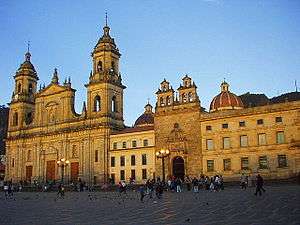Mérida Cathedral
| Mérida Cathedral | |
|---|---|
|
The Mérida Cathedral | |
| Basic information | |
| Location | Mérida, Yucatán, Mexico. |
| Geographic coordinates | 20°58′1.64″N 89°37′21.32″W / 20.9671222°N 89.6225889°WCoordinates: 20°58′1.64″N 89°37′21.32″W / 20.9671222°N 89.6225889°W |
| Affiliation | Roman Catholic |
| Status | Preserved |
| Architectural description | |
| Architect(s) | Juan Miguel de Agüero |
| Architectural type | Cathedral |
| Completed | 1598[1] |
| Materials | Stone |
The Mérida Cathedral in Mérida, Yucatán, Mexico, is one of the oldest cathedrals in the Americas.[1]
History
The cathedral was built on the site of Mayan ruins Tiho.[1]
The cathedral of Merida, seat of the bishopric of Yucatan, was the first cathedral to be finished on the American mainland, and the only one (with the exception of Santo Domingo de Guzman on the island of Hispaniola) to be entirely built during the 16th century. It is a unique monument with clear antecedents in Andalucia.
The bishopric of Yucatan had an uncertain start. The Yucatan peninsula was explored by Francisco Hernandez de Cordova and Juan de Grijalva on behalf of Diego Velazquez de Cuellar, the adelantado of Cuba, in 1517 and 1518. The creation of a diocese in the recently discovered country was urged by Velazquez, who presumed to have jurisdiction over the region and hoped to colonize it. A see known as "Carolense" was indeed created by Pope Leo X in 1519 (later renamed "Our Lady of Remedies" by Clement VII). But said diocese was not implemented in the territory of Yucatan but in that of Tlaxcala instead and later on was moved to Puebla. It cannot therefore be considered the predecessor of the diocese of Yucatan.
The diocese of Yucatan proper, named "Yucatan and Cozumel," was created by Pius IV in 1561. St. Ildephonsus of Toledo was invoked as the patron. Two prelates for the new see were nominated in succession by the Spanish Crown but neither could be consecrated for entirely accidental reasons. A third candidate, fray Francisco Toral, was eventually consecrated and took possession on August 14, 1562. He was the first of a long line of bishops, later archbishops, of Yucatan.
Meanwhile, land had been set aside for the cathedral at Merida, the place recycled by the Spanish under Francisco de Montejo as the capital of the new colony. The colonial city was set amidst the ruins of the Maya settlement of Ichcansiho (T'ho for short), and work for the church was begun shortly after Toral's arrival. The church was to be built on the eastern side on the main town square, where a temporary building was erected.
The system of vaulting used throughout the building was based on the ideas of Andres de Vandelvira, first applied to the building of the cathedral of Jaen. Indeed, there is every possibility that Vandelvira's schemes were brought to the Merida project by the first bishop of Yucatan, fray Francisco Toral, who hailed from Ubeda, a town in the Jaen province.
References
| Wikimedia Commons has media related to Mérida - Cathedral de San Ildefonso. |
- 1 2 3 Rasmussen, Christian (October 1998). "Yucatán's church of all ages". Americas. Retrieved 2009-01-03.

